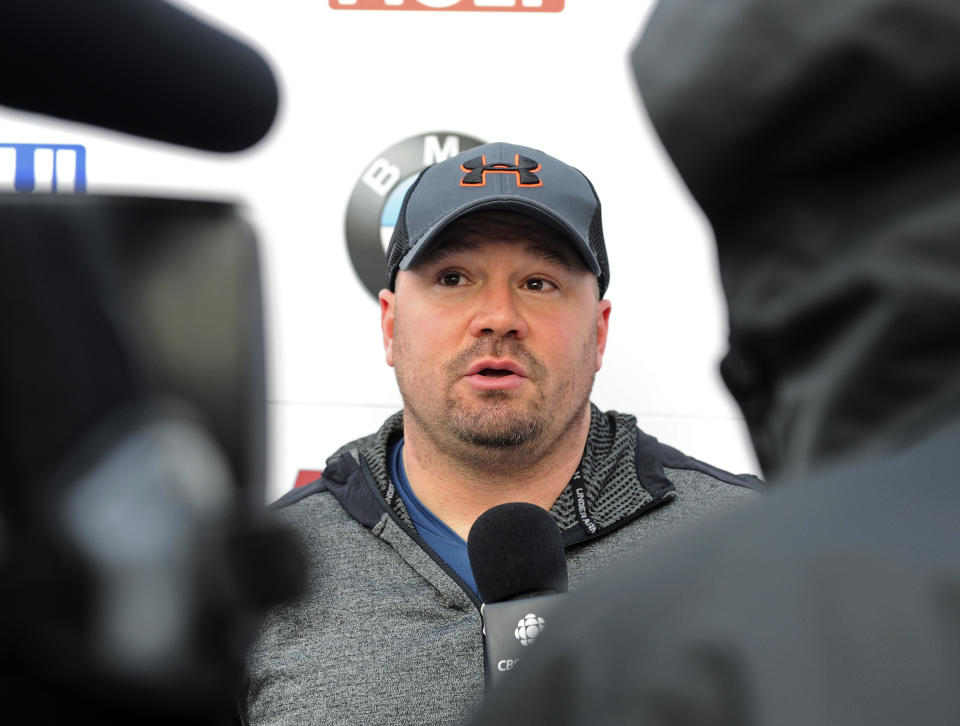Steven Holcomb's legend lives on with U.S. bobsled team at Winter Olympics
PYEONGCHANG, South Korea – It was at a promotional event a couple of years ago, something for BMW, and Aja Evans turned around to see Steven Holcomb smirking.
“There are cupcakes back there,” the Team USA bobsled pilot said, barely able to hold his grin back.
Evans had a minor conniption, immediately wanting a cupcake and worrying that she had missed her chance already.
“Don’t worry,” Holcomb told her. “I got you.”
At the end of the event, he presented Evans with a Team USA cupcake covered in red frosting. He had saved her one.
Evans smiles at the story.
“It was one of my last memories of him,” she said.
Evans was in the car with her sister last May when she saw a news release from Team USA. Steven was gone.
Holcomb, the best bobsled pilot of his generation, was found dead in his room in Lake Placid, New York. He was only 37. An early report suggested a lethal combination of alcohol and sleeping pills in his system. His family has sought to keep the details private, but Holcomb had battled depression. In 2007, he had taken sleeping pills and Jack Daniels in an attempt at suicide.
“When I was reading [the news], my jaw dropped and I just froze,” Evans said. “I couldn’t speak.”

It wasn’t just that Holcomb was a bobsled legend; he was a bobsled institution. The story of the modern sport cannot be written without him. The Americans had not won an Olympic bobsled title since 1948 when Holcomb’s four-man team struck gold in Vancouver. He was preternaturally gifted as a driver and even more so as a leader.
“I don’t know my sport without Steve,” pilot Justin Olsen said back in September. “I’ve asked Steve so many personal questions, in and out of the sport. Should I join the Army? The coaches want me to drive; should I drive?”
Bobsled has an extremely tight community – on the men’s and women’s side. The travel is so intense that many of the sport’s elite competitors don’t even have a real residence. Steven Langton, who has been involved with the sport since 2007, said his driver’s license says Massachusetts but he spent a total of 15 days there last year. “Can’t get rid of each other for six months,” Langton joked.
But that allows a closeness that major pro sports don’t have. You don’t go back to your gated mansion after a big event. You get into the car with your teammates and you drive two or 12 hours across Europe. Evans said she would find a sauna in a foreign place to get away from it all, and there was Steven who had the same exact idea.
“That’s the beauty in our sport; we become family,” Evans said. “Good bad or ugly, we all are so close, we all have each other’s back.”
The den leader was “Holky.” He had a youthful charm as well as an old soul. He wrote in his book that the first weight of depression fell on him as a teenager. He knew that demon well. He fought. He spoke openly but he also suffered privately. He nearly lost his vision as a young racer, and that itself led to a spiral, but he roared back and made history.
So this week, as both the American men and women go for gold, it’s strange. It’s sad.
“It didn’t feel real [when he died],” Evans said. “It still doesn’t.”
It may never feel real. Holcomb has shared a little bit of himself with all of the racers here, whether through knowledge or inspiration or spirit or all of the above. This is still his team. It’s still his dream. He’s still in that sled with every one of his fellow racers.
It’s just difficult to grasp that his voice is now only in their heads.
More Olympic coverage from Yahoo Sports:
• Vonn speaks on deadly Florida shooting: ‘I can’t understand it’
• Vonn’s timeline filled with hate tweets after Super-G loss
• Wetzel: Rippon off to have a stiff drink with mission accomplished
• Adelson: Why Zhou could be star to watch at 2022 Olympics


